Annual report 2021-22 - Agency's performance
Performance at a glance
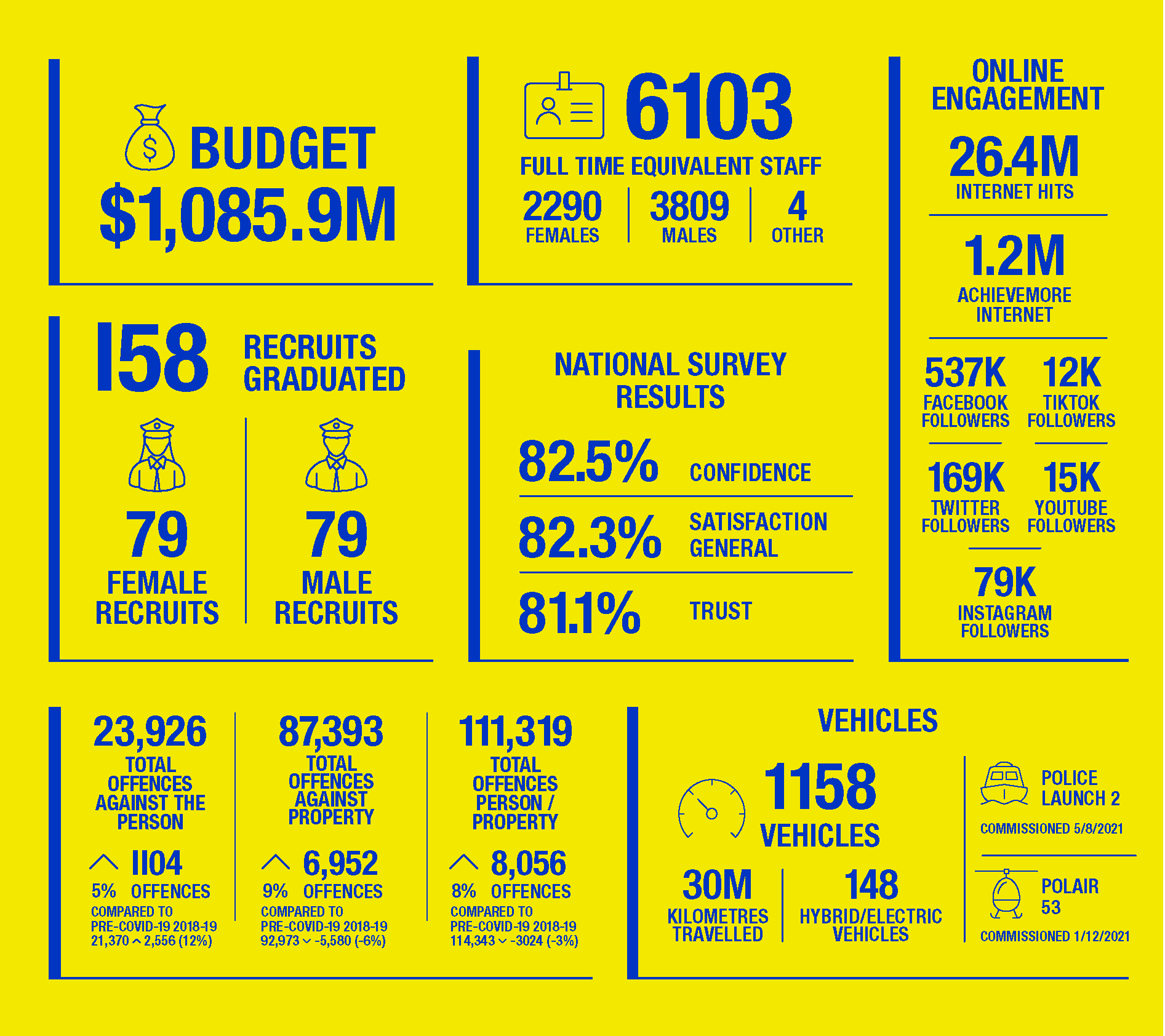
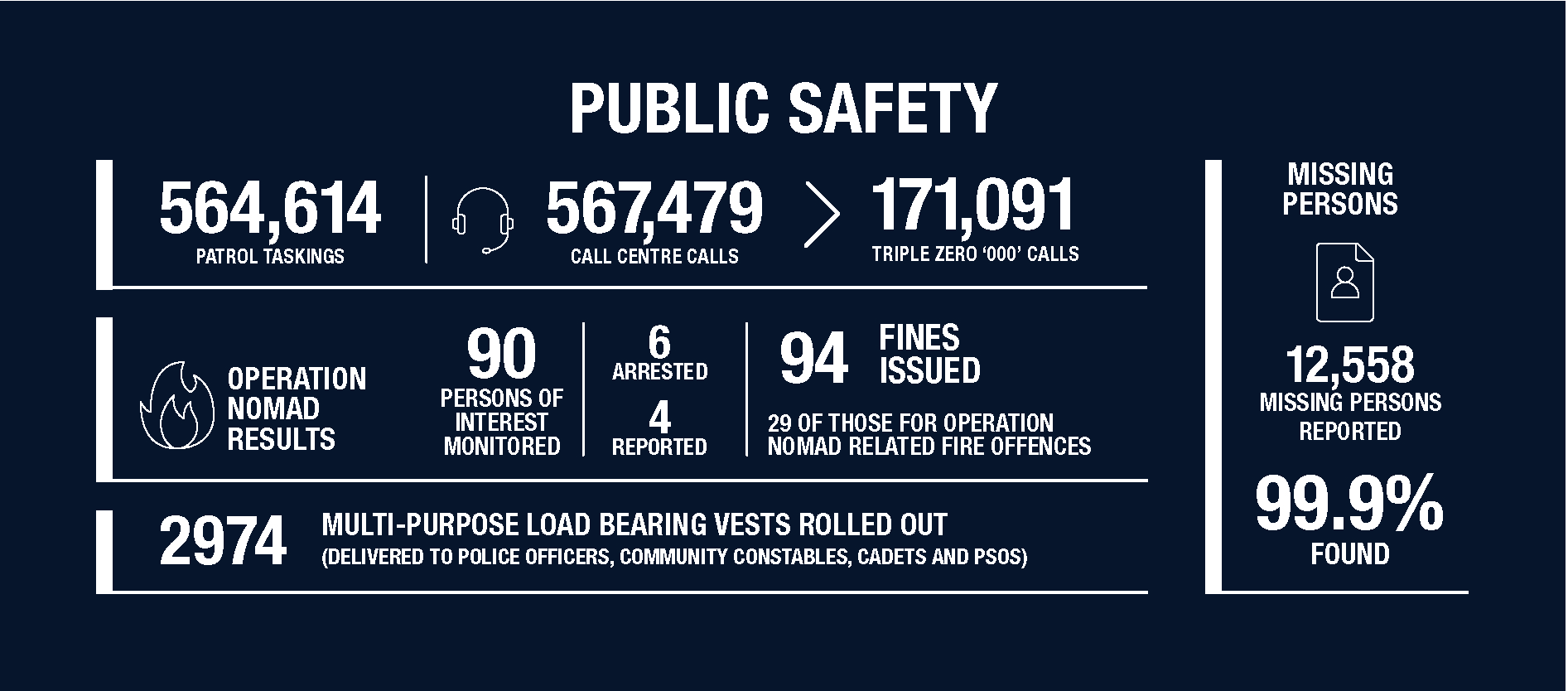
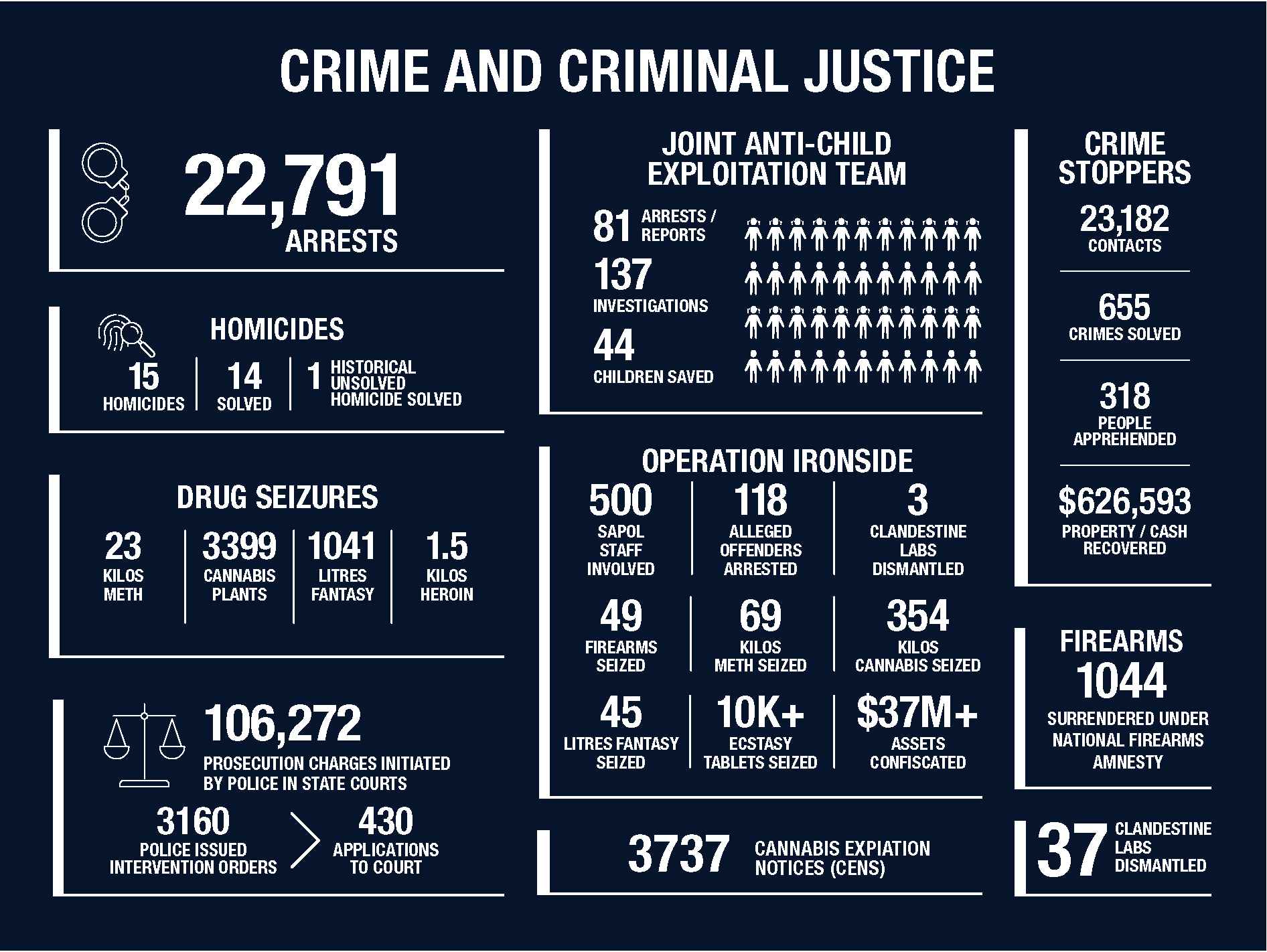
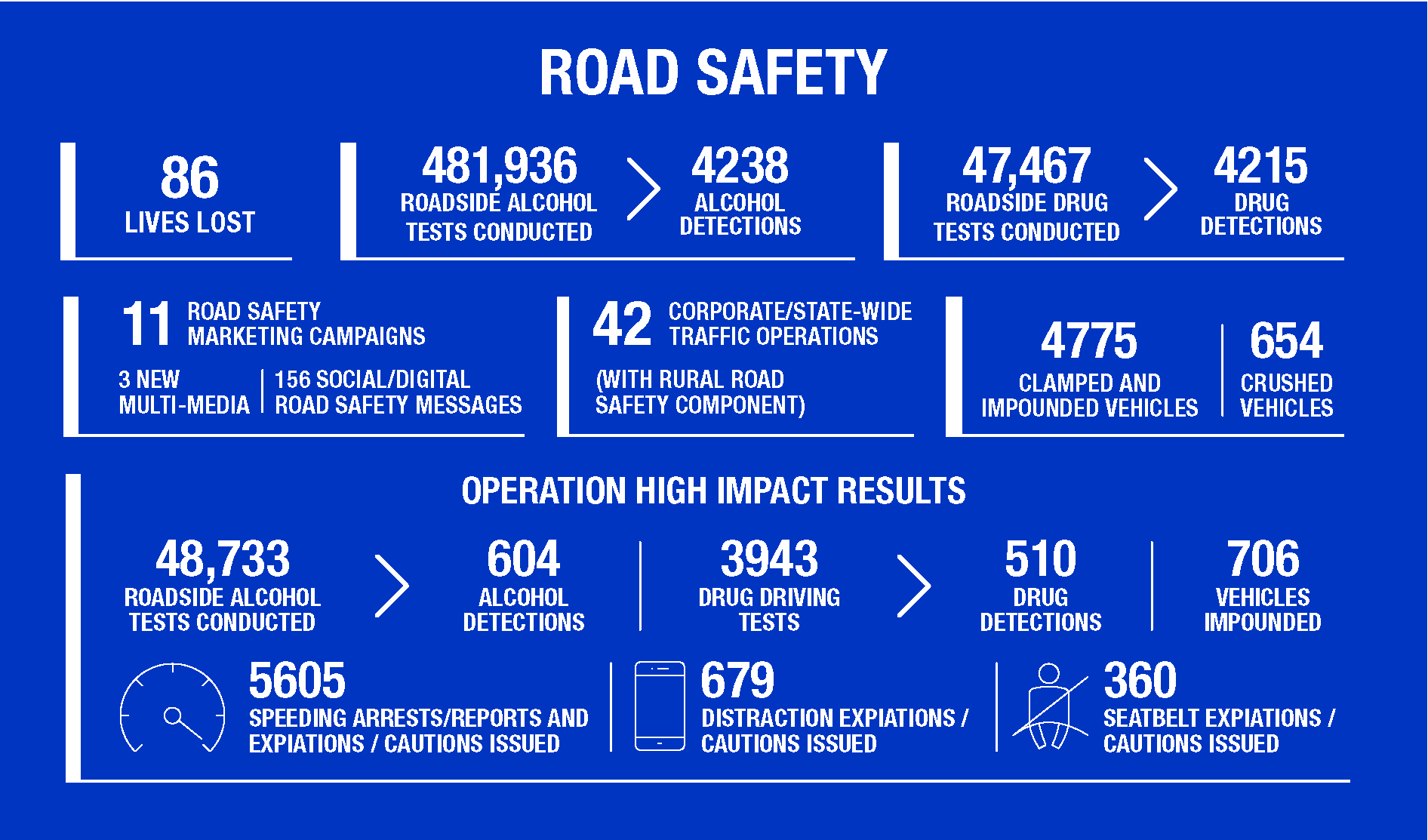
Agency response to COVID-19
From 1 July 2021 until the revocation of the Emergency Management Declaration on 24 May 2022, Commissioner Stevens continued as State Coordinator under the Emergency Management Act 2004.
Directions that were enforced at the time have been transitioned to the
South Australian Public Health Act 2011.
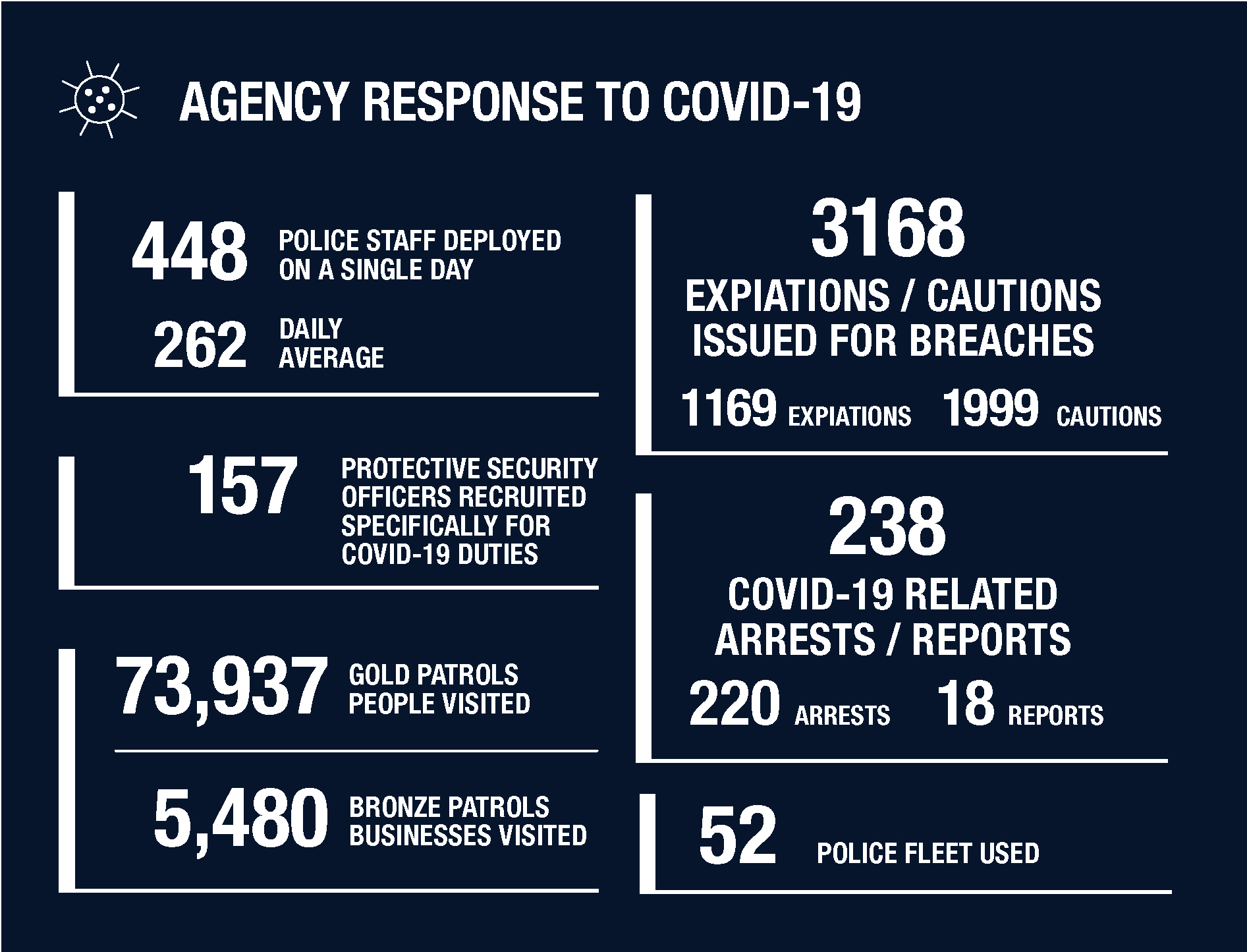
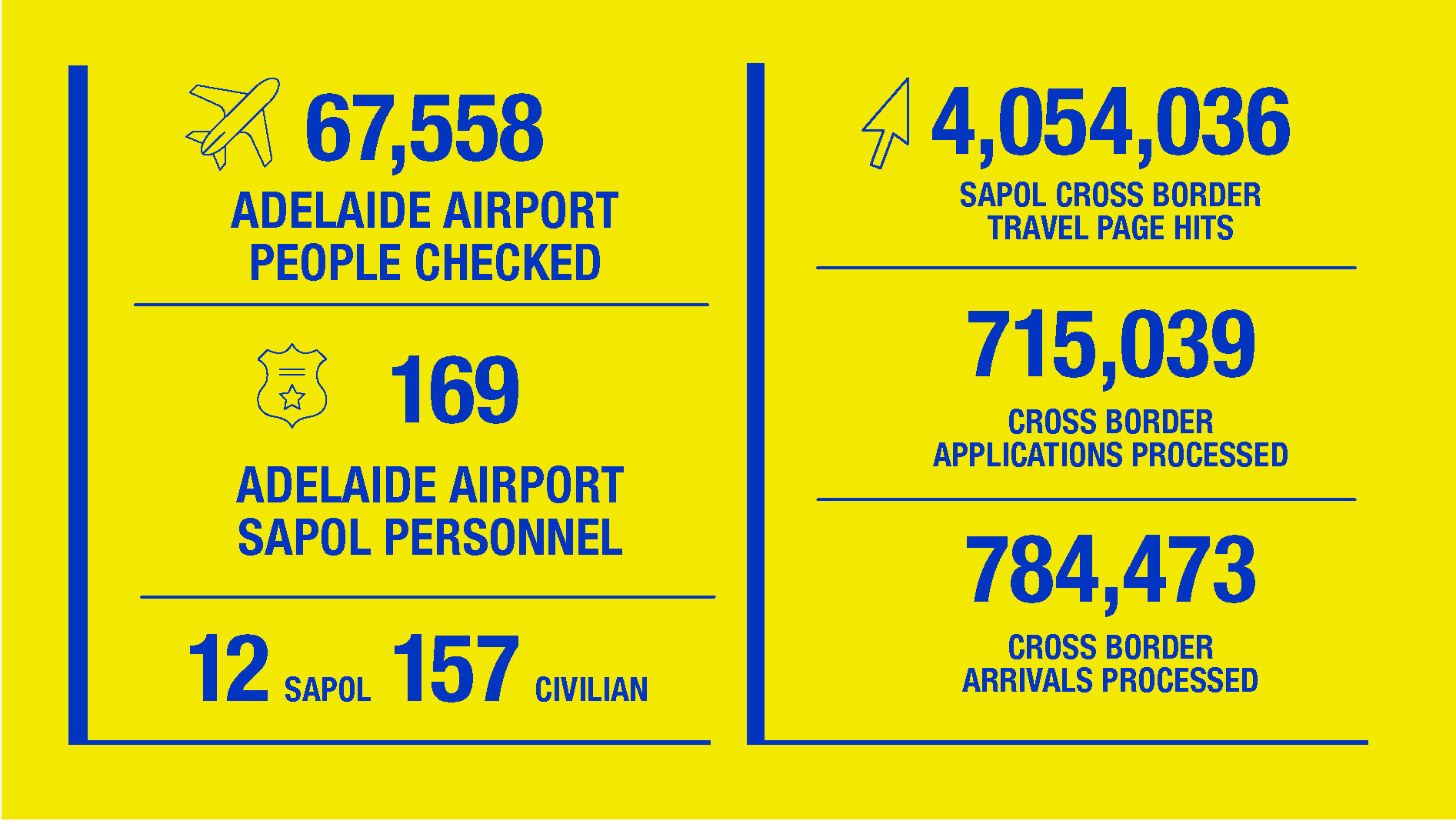
Agency contribution to whole of Government objectives
Agency’s contribution |
|---|
SAPOL remains steadfast in its commitment to building safer communities through the delivery of policing priorities: Public Safety; Crime and Criminal Justice Services; and Road Safety.
A 2022 election commitment was to establish a Premiers Taskforce to make recommendations on increasing the number of sworn Police Officers and Protective Security Officers (PSOs) over the next 10-15 years. The Taskforce will include representatives of Government, SAPOL and the Police Association of South Australia, with the first meeting to be held in August 2022.
A 2022 election commitment was to fund SAPOL $6.5 million for an additional 1,500 personal issue, Multi-Purpose Load Bearing Vests (MPLBV) to protect police and police security officers carrying out their duties. Implementation of this initiative is being staged over a two year period. MPLBV’s have specific use, care and storage requirements and to ensure compliance with contractual and warranty obligations, SAPOL is currently undertaking capital works to enable correct storage.
Having nurses located at metropolitan custodial facilities reduces the need for police to attend a hospital with detainees. Originally an SA Health funded program, Pop-Up Medic Nurses provide operational efficiencies for SAPOL and SA Health as well as enhanced levels of medical care for detainees in Police custody. The use of these nurses within the custodial facilities assisted in the reduction of the flow of detainees to emergency departments as part of the State’s COVID-19 health strategy. The program has further developed to provide additional services, including the conduct of forensic procedures, providing additional operational efficiencies for SAPOL – and was expanded during the reporting period to incorporate custodial nurses into a regional centre at Port Augusta. |
Agency specific objectives and performance
Agency objectives | Indicators | Performance |
|---|---|---|
Public Safety | Level of Community Confidence in policing services. Percentage of Grade 1 tasking’s in the metropolitan area responded within 15 minutes. Number of calls received by Call Centre. Number of 000 calls presented to Police Communications Centre by Telstra. | 82.5% 94.8%, above the target of ≥80.0% 567 479 171 091 |
Crime and Criminal Justice Services | Number of recorded offences against the person as reported by/on behalf of victims per 1000 head of population. Number of recorded offences against property as reported by/on behalf of victims per 1000 head of population. | 13.26 above projection of ≤12.44 48.46 below the projection of ≤49.29 |
Road Safety | Number of Road Safety Contacts issued personally involving unique expiation notices and apprehension reports/incident reports excluding camera. Number of driver screening tests conducted.* Number of Road Safety Centre attendees, children and young adults (16-24 years). Total number of people attending SAPOL road safety programs. | 142 683 481 936 below the target of 500 000 268 42 997 |
* Results reflect the impact of COVID-19 on activities.
Corporate performance summary
Crime Trends
Offence counts and groupings are in line with the Australian Bureau of Statistics (ABS) Australian and New Zealand Standard Offence Classification (ANZSOC).
Over the 10 year period from financial year 2012-13 to 2021-22 there has been a very slight decrease in overall recorded crime of 0.02% or 25 offences
(111 344 to 111 319) for total offences against person and property.
During the last two years COVID-19 has had an impact on all aspects of South Australia life. Therefore, to give some context to crime reporting, for this 2021-22 reporting period, the 2018-19 financial year crime data is referenced to allow pre-COVID-19 comparison. From 2018-19 to 2021-22, there was a decrease in overall recorded crime of 2.6% or 3 024 offences (114 343 to 111 319).
Total Offences Against Person and Property
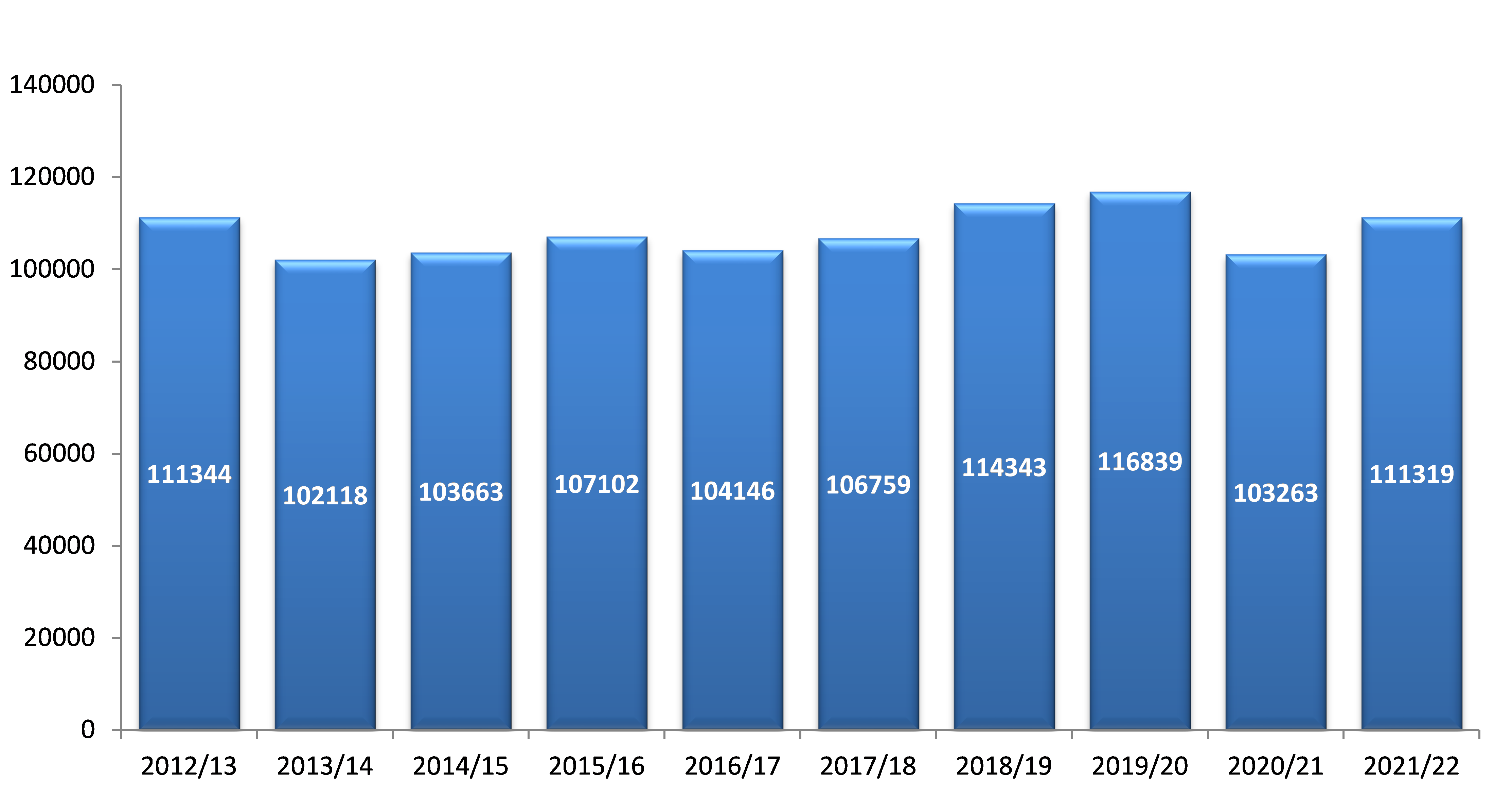
Note: There may be some variations in numbers due to data refresh.
In summary, from 2020-21 to 2021-22, there was an increase in overall recorded crime of 7.8% or 8 056 offences (103 263 to 111 319).
Crime statistics are published online at https://www.police.sa.gov.au each month.
Total Offences Against the Person
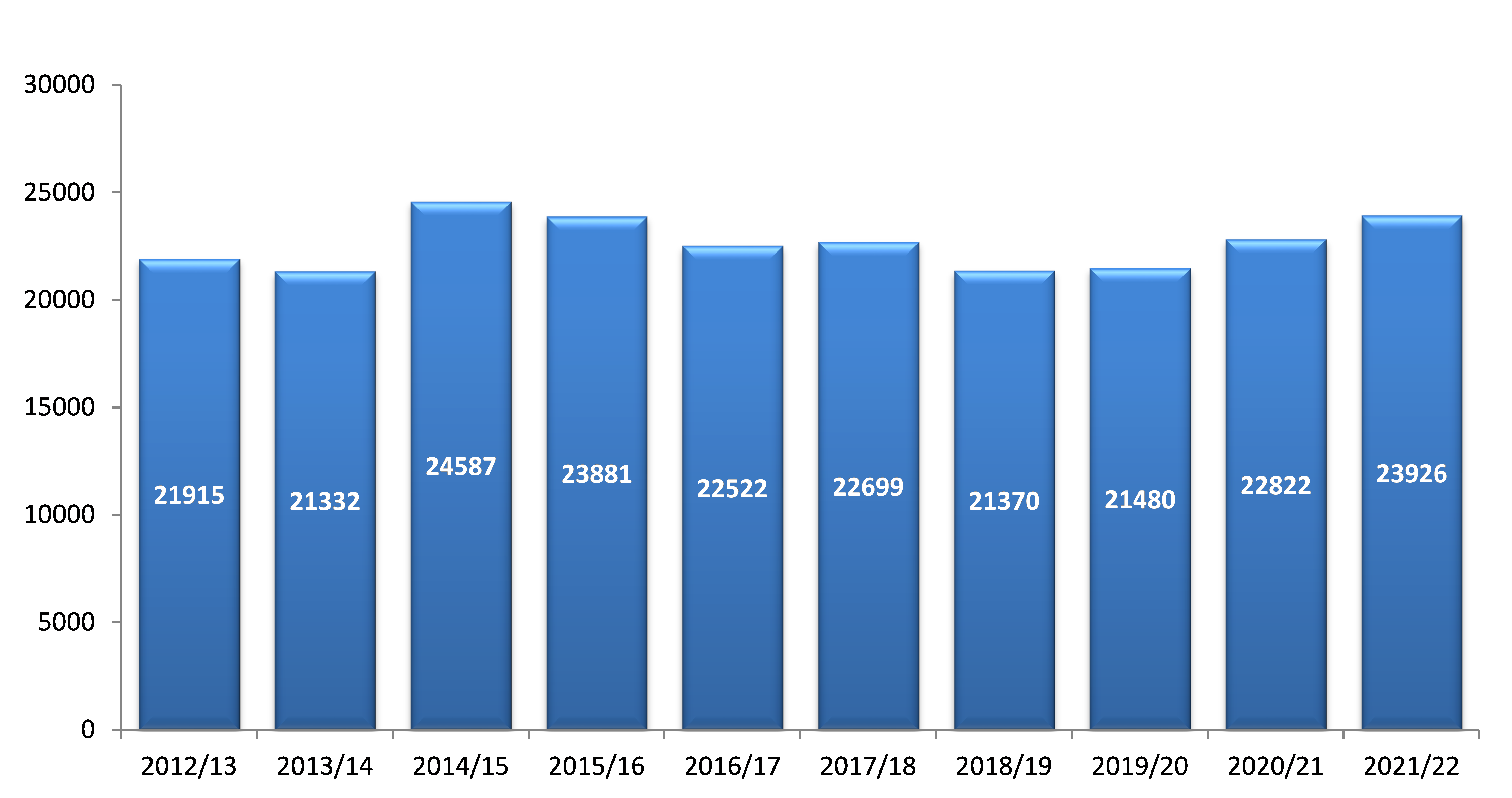
Note: There may be some variations in numbers due to data refresh.
OFFENCES AGAINST THE PERSON | Current Reporting Period | Pre-COVID-19 Context | ||||
|---|---|---|---|---|---|---|
Financial Year | Financial Year | |||||
2020-21 | 2021-22 | Change | 2018-19 | 2021-22 | Change | |
Homicide and Related Offences | 43 | 40 | -7.0% | 53 | 40 | -24.5% |
Acts Intended to Cause Injury | 18 605 | 19 761 | 6.2% | 16 757 | 19 761 | 17.9% |
Sexual Assault and Related Offences | 2 215 | 2 103 | -5.1% | 1 948 | 2 103 | 8.0% |
Robbery and Related Offences | 520 | 671 | 29.0% | 584 | 671 | 14.9% |
Other Offences Against the Person | 1 439 | 1 351 | -6.1% | 2 028 | 1 351 | -33.4% |
TOTAL OFFENCES AGAINST THE PERSON | 22 822 | 23 926 | 4.8% | 21 370 | 23 926 | 12.0% |
Family & Domestic Abuse-Related | 9 834 | 10 037 | 2.1% | 8 246 | 10 037 | 21.7% |
Homicide and Related Offences decreased by 7.0% (3 offences), compared to 2018-19 decreased by 24.5% (13 offences).
Acts Intended to Cause Injury increased by 6.2% (1 156 offences), compared to 2018-19 increased by 17.9% (3 004 offences). Within this category Common Assault increased by 59.4% (1 893 offences), compared to pre-COVID-19 results decreased by 23.9% (1 599 offences).
Sexual Assault and Related Offences decreased by 5.1% (112 offences), compared to 2018-19 increased by 8.0% (155 offences). Within this category, Aggravated Sexual Assault decreased by 4.6% (61 offences), Non-Aggravated Sexual Assault decreased by 7.2% (34 offences) and Non-Assaultive Sexual Offences decreased by 4.2% (17 offences). Compared to 2018-19 Aggravated Sexual Assault increased by 7.3% (87 offences), Non-Aggravated Sexual Assault increased by 11.5% (45 offences) and Non-Assaultive Sexual Offences increased by 6.2% (23 offences).
Robbery and Related Offences increased by 29.0% (151 offences), compared to 2018-19 increased by 14.9% (87 offences). Within this category, Aggravated Robbery Offences increased by 24.3% (88 offences), compared to 2018-19 increased by 10.6% (43 offences).
Total Offences Against Property
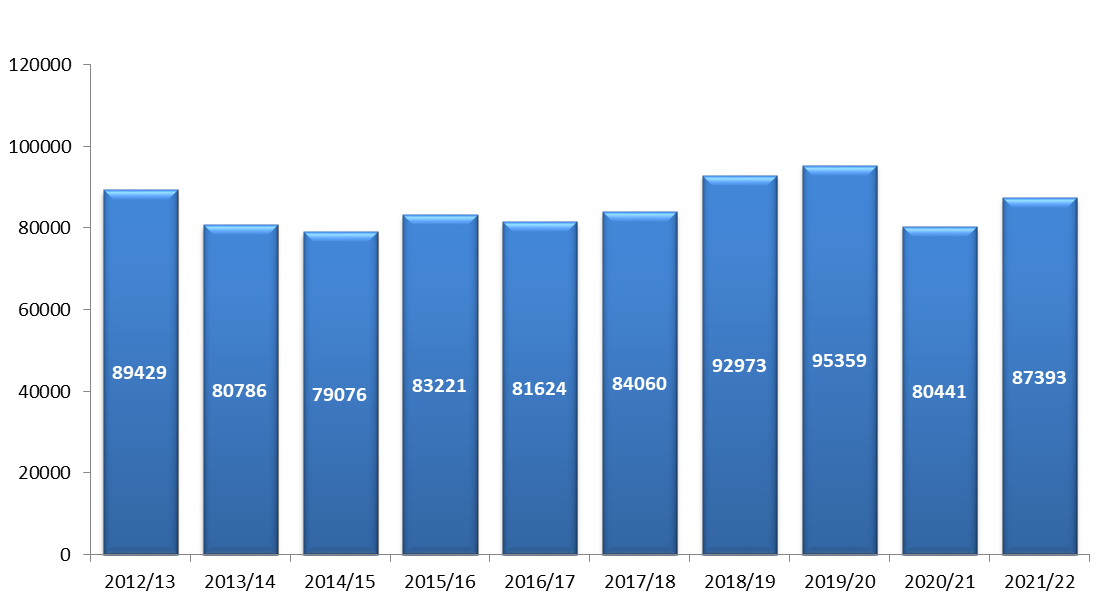
Note: There may be some variations in numbers due to data refresh.
OFFENCES AGAINST PROPERTY | Current Reporting Period Financial Year | Pre-COVID-19 Context Financial Year | ||||
|---|---|---|---|---|---|---|
2020-21 | 2021-22 | Change | 2018-19 | 2021-22 | Change | |
Serious Criminal Trespass | 12 130 | 12 519 | 3.2% | 16 272 | 12 519 | -23.1% |
Theft and Related Offences | 43 128 | 47 834 | 10.9% | 51 097 | 47 834 | -6.4% |
Fraud, Deception and Related Offences | 4 882 | 5 990 | 22.7% | 4 218 | 5 990 | 42.0% |
Property Damage and Environmental | 20 301 | 21 050 | 3.7% | 21 386 | 21 050 | -1.6% |
TOTAL OFFENCES AGAINST PROPERTY | 80 441 | 87 393 | 8.6% | 92 973 | 87 393 | -6.0% |
Family & Domestic Abuse-Related | 3 194 | 3 307 | 3.5% | 2 621 | 3 307 | 26.2% |
Serious Criminal Trespass (SCT) increased by 3.2% (389 offences), compared to 2018-19 decreased by 23.1% (3 753 offences). Within this sub-category, SCT - Residence increased by 7.3% (399 offences), while SCT - Non Residence decreased by 1.5% (55 offences), compared to 2018-19 SCT - Residence decreased by 30.7% (2 597offences) and SCT - Non Residence decreased by 16.9% (746 offences).
Theft and Related Offences increased by 10.9% (4 706 offences), compared to 2018-19 decreased by 6.4% (3 263 offences). Within this sub category, Theft from shop increased by 29.8% (2 891 offences), compared to 2018-19 increased by 19.1% (2 020 offences).
Fraud Deception and Related Offences increased by 22.7% (1 108 offences), compared to 2018-19 increased by 42.0% (1 772 offences). Within this sub category Obtain benefit by deception increased by 34.9% (1 352 offences), compared to 2018-19 increased by 61.6% (1 992 offences).
Property Damage and Environmental Offences increased by 3.7% (749 offences), compared to 2018-19 decreased by 1.6% (336 offences). Within this sub-category, Other property damage and environmental increased by 5.2% (930 offences), compared to 2018-19 increased by 2.5% (449 offences). Environmental relates to the natural world and the impact of human activity e.g. environmental noise.
Total Offences Against Good Order
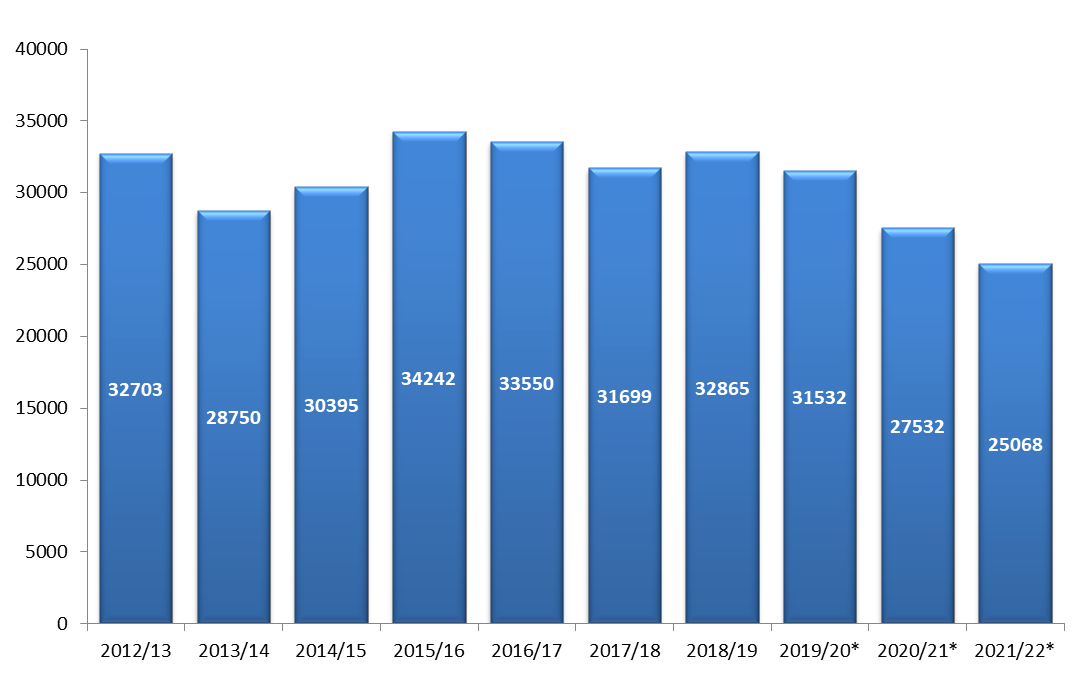
Note: There may be some variations in numbers due to data refresh.
* Numbers reflect COVID-19 related restrictions in community based activity and business operations.
OFFENCES AGAINST GOOD ORDER | Current Reporting Period | Pre-COVID-19 Context | ||||
|---|---|---|---|---|---|---|
Financial Year | Financial Year | |||||
2020-21 | 2021-22 | Change | 2018-19 | 2021-22 | Change | |
Illicit Drug Offences | 3 910 | 2 909 | -25.6% | 5 859 | 2 909 | -50.3% |
Weapons/Explosives Offences | 2 518 | 2 371 | -5.8% | 3 183 | 2 371 | -25.5% |
Public Order Offences | 4 087 | 3 880 | -5.1% | 4 670 | 3 880 | -16.9% |
Justice Procedure Offences | 16 102 | 15 136 | -6.0% | 17 767 | 15 136 | -14.8% |
Other Miscellaneous Offences | 915 | 772 | -15.6% | 1 386 | 772 | -44.3% |
TOTAL OFFENCES AGAINST GOOD ORDER | 27 532 | 25 068 | -8.9% | 32 865 | 25 068 | -23.7% |
Illicit Drug Offences decreased by 25.6% (1 001 offences), compared to 2018-19 decreased by 50.3% (2 950 offences). The main contributor is Possess / Use Drug Offences which decreased by 24.4% (371 offences), compared to 2018-19 decreased by 55.4% (1 428 offences).
Weapons/Explosives Offences decreased by 5.8% (147 offences), compared to 2018-19 decreased by 25.5% (812 offences). The main contributor is Prohibited Weapons/Explosives Offences which decreased by 26.4% (239 offences), compared to 2018-19 decreased by 34.5% (350 offences).
Public Order Offences decreased by 5.1% (207 offences), compared to 2018-19 decreased by 16.9% (790 offences). Within this category, Trespass increased by 13.0% (57 offences) and Criminal intent decreased by 20.2% (86 offences), compared to 2018-19 Trespass decreased by 21.0% (132 offences) and Criminal intent decreased by 38.0% (208 offences).
Justice Procedure Offences decreased by 6.0% (966 offences), compared to 2018-19 decreased by 14.8% (2 631 offences). Within this category, Breach of Bail decreased by 8.4% (774 offences), compared to 2018-19 decreased by 19.4% (2 039 offences).
Total General Expiations, Cannabis Expiations and Drug Diversions
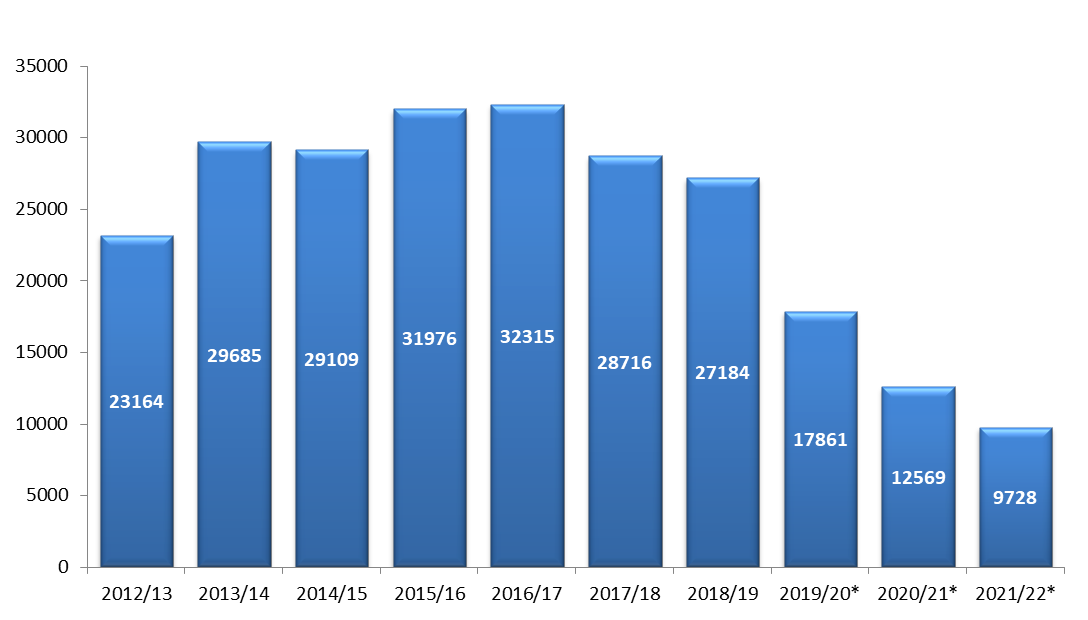
Note: There may be some variations in numbers due to data refresh.
* Numbers reflect COVID-19 related restrictions in community based activity and business operations.
GENERAL EXPIATION OFFENCES (GENs) | Current Reporting Period | Pre-COVID-19 Context | ||||
|---|---|---|---|---|---|---|
Financial Year | Financial Year | |||||
2020-21 | 2021-22 | Change | 2018-19 | 2021-22 | Change | |
Other Theft (GENs) | 335 | 182 | -45.7% | 3 943 | 182 | -95.4% |
Other Property Damage and Environmental (GENs) | 11 | 13 | 18.2% | 7 | 13 | 85.7% |
Cannabis Expiation Notices (CENs) | 5 253 | 3 737 | -28.9% | 8 317 | 3 737 | -55.1% |
Drug Diversions | 2 389 | 1 837 | -23.1% | 6 432 | 1 837 | -71.4% |
Other Weapons / Explosives Offences (GENs) | 102 | 65 | -36.3% | 120 | 65 | -45.8% |
Other Public Order Offences (GENs) | 3 727 | 3 421 | -8.2% | 7 374 | 3 421 | -53.6% |
Other Justice Procedure Offences (GENs) | 88 | 75 | -14.8% | 121 | 75 | -38.0% |
Other Miscellaneous Offences (GENs) | 664 | 398 | -40.1% | 870 | 398 | -54.3% |
TOTAL GENERAL EXPIATION OFFENCES | 12 569 | 9 728 | -22.6% | 27 184 | 9 728 | -64.2% |
Total General Expiations decreased by 22.6% (2 841 GENs), compared to 2018-19 decreased by 64.2% (17 456 offences). Cannabis Expiation Notices (CENs) decreased by 28.9% (1 516 CENs) and Drug Diversions decreased by 23.1% (552 Diversions). Compared to 2018-19, Cannabis Expiation Notices decreased by 55.1% (4 580 offences) and Drug Diversions decreased by 71.4% (4 595 offences).
The Police Drug Diversion Initiative (PDDI) implemented changes which took effect on 1 April 2019. An adult can only be referred to the PDDI no more than twice in a four year period, on the third detection the adult is referred directly to court.
Employment opportunity programs
Program name | Performance |
|---|---|
Aboriginal Employment Register (AER) | SAPOL is committed to supporting government initiatives and programs that support the employment of Aboriginal people within the public sector. As such, the Human Resources Service developed the SAPOL People Strategy 2021-2025 with one of its key priorities to attract, develop and retain a diverse workforce with an inclusive culture within SAPOL. As part of this, SAPOL continues to consider Aboriginal people from the AER when filling non-sworn vacancies in order to help them with their career and offer professional and development opportunities. |
Agency performance management and development systems
Performance management and development system | Performance |
|---|---|
Individual Performance Management | SAPOL’s online Individual Performance Management and Development system (iEngage performance and development) runs over a 12 monthly cycle with a mid-term review 6 monthly before completing and recommencing. Introduced in November 2019, iEngage is focused on promoting a meaningful and purposeful feedback framework between employees and supervisors that will ensure ongoing development of the individual whilst incorporating wellbeing, performance improvement and workplace behaviour expectations. Underpinning this approach is the expectation of regular performance and development discussions between supervisors and employees. The system has two primary elements:
It is a requirement for all eligible employees to have an up to date iEngage performance and development plan and compliance is monitored and reported through the Executive Leadership Team on a monthly basis. |
Work health, safety and return to work programs
| Program name | Performance |
|---|---|
Work health and safety programs | A total of 2 276 incidents were reported in 2021-22, reflecting a 5% reduction compared with 2020-21. Of these, 1 111 incidents resulted in injury whilst 1 165 incidents resulted in no injury. Additionally, a total of 285 hazard reports were submitted in 2021-22 reflecting a 21% decrease compared with 2020-21. The Worksite Inspections program achieved a 99% completion rate in 2021-22. A Heat Risk Management Campaign was launched to raise awareness of hazards and risk mitigation strategies when working during hot weather. An Infection Control Campaign was launched to promote risk mitigation of contracting COVID-19 and Influenza. An enhanced Personal Protection Equipment (PPE) decision guide was developed to assist workers determine the type of PPE required based on a dynamic risk assessment. As part of minimising the risk of exposure to COVID-19 in high risk environments, 927 members were mask fit tested for a Particulate Filter Respirator and trained. 3 658 influenza vaccinations were administered as part of the annual voluntary Influenza Vaccination Program for employees and immediate family members. A gap analysis of SAPOL’s Work Health and Safety system framework against the globally recognised standards ISO 45001:2018 Occupational Health and Safety Management Systems and ISO 45003:2021 Psychological Health and Safety at Work - Guidelines for Managing Psychosocial Risks was completed. The Commissioner’s Occupational Health Safety and Welfare Advisory Committee, SAPOL’s principal consultative committee involving management and industrial association officials, continued to monitor and review safety performance and issues impacting employee health, safety and wellbeing. |
Employee Assistance | The Employee Assistance Program (EAP) is an external professional counselling service delivered by mental health professionals, offering support for work-related and personal problems provided by Corporate Health Group. The EAP is a confidential service available to all employees and immediate family members who can access up to six sessions every two years. During 2021-22, the EAP resulted in 324 initial consultations, 8% higher than 2020-21 and a total of 954 consultations, 29% higher than 2020-21. The COVID-19 Employee Assistance Hotline continued to support the workforce throughout 2021-22 by providing wellbeing checks on close contacts or COVID-19 positive, information on COVID-19 directions and industrial entitlement advice. The COVID-19 Employee Assistance Hotline also administered the Employee Assistance Section COVID-19 online reporting form and dashboard, and the vaccination compliance dashboard. |
Early Intervention | The Early Intervention Program (EIP) supports employees with work related injuries and aims to act early to minimise the impact and duration of emerging symptoms or actual injury or illness. To achieve this, an early assessment of needs is undertaken within 48 hours of a reported incident through direct contact with the employee and their supervisor. The program then provides injured employees with early and appropriate treatment with providers of their choice, to assist with recovery while remaining at work. Where the employee experiences an absence from work, referrals are made to appropriate services with the aim of achieving the best practicable levels of physical and/or mental recovery. Participation in the program is voluntary and does not impact the ability to lodge a work injury claim in future. In 2021-22 a total of 1 341 early intervention assessments were undertaken. Of these, 91% were undertaken within 48 hours of incident reporting, exceeding the 80% performance target. The early intervention assessments resulted in the following outcomes:
|
Reconditioning Program and Preferred Health Service Providers List | SAPOL implemented a range of health and wellbeing initiatives designed to promote healthy living and improve the overall health of the workforce by delivering evidenced based education/advice, providing health and fitness equipment and offering support to those in need. The Reconditioning Program links staff with appropriate allied health service providers and helps by covering any out of pocket expenses. The program is open to all employees wishing to improve their physical health and excludes work related injuries. In 2021-22, 289 employees participated and 1 350 consultations occurred. Supporting the Reconditioning Program is SAPOL’s ‘Preferred Health Service Providers List’ which currently has 260 allied health practitioners participating in the program. This list allows SAPOL to communicate with treating allied health professionals regarding the unique nature of policing and better inform our workforce of service providers that best suit their needs. Services are provided by dieticians, physiotherapists, exercise physiologists, podiatrists and sleep clinicians. |
Operational Nutrition Support | Operational Nutrition Support is an online nutrition program designed for SAPOL by accredited dietitians from Sprout Nutrition. The program aims to teach nutrition basics such as reading food labels, portion control, healthy eating as well as addressing how food influences sleep, energy levels and mood. The topics are specifically designed for shift workers but are broad enough to benefit the broader workforce. In 2021-22 the program had a total of 482 enrolments and 1 650 hours of online learning undertaken. |
Body Scan Program | SAPOL has purchased an InBody 570 unit which measures and analyses an individual’s body composition in terms of water, fat, protein, muscle and bone mineral. The device can determine the weight and percentage of lean muscle mass and body fat in segmented body parts. Results are used to springboard participants into physical health improvement programs such as the Reconditioning Program mentioned above. In 2021-22, 700 body scans were conducted. |
Fitness Passport | In April 2022, SAPOL launched the Fitness Passport Program. The program allows SAPOL employees and their families to pay a small weekly fee to gain access to a ‘passport’ to over 55 health and fitness centres. Since its launch, the program has resulted in 667 participants. |
Workplace injury claims | Current year | Past year | % Change |
|---|---|---|---|
Total new workplace injury claims* | 352 | 363 | -3% |
Fatalities | 1 | 0 | +100% |
Seriously injured workers** | 0 | 0 | 0 |
Significant injuries (where lost time exceeds a working week, expressed as frequency rate per 1000 FTE) | 25.90 | 17.07 | +52% |
Data extract run 1/7/2022
* Excludes additional compensation claims
** Number of claimants assessed during the reporting period as having a whole person impairment of 30% or more under the Return to Work Act 2014 (Part 2 Div 5).
Work health and safety regulations | Current year | Past year | % Change |
|---|---|---|---|
Number of notifiable incidents (Work Health and Safety Act 2012, Part 3) | 10 | 5 | +50% |
Number of provisional improvement, improvement and prohibition notices (Work Health and Safety Act 2012 Sections 90, 191 and 195) | 0 | 1 | -100% |
Return to work costs* | Current year | Past year | % Change |
|---|---|---|---|
Total gross workers compensation expenditure ($) | $19 748 915 | $23 521 763 | -16% |
Income support payments – gross ($) | $10 496 777 | $14 706 691 | -29% |
* Based on twelve months of data before third party recovery; excludes additional compensation costs.
Data for previous years is available at:
https://data.sa.gov.au/data/dataset/annual-reporting-data
Executive employment in the agency
Executive classification | Number of executives |
|---|---|
Commissioner | 1 |
Deputy Commissioner | 1 |
Assistant Commissioners | 8 |
SA Executive Service Level 2 | 3 |
SA Executive Service Level 1 | 6 |
Data for previous years is available at:
https://data.sa.gov.au/data/dataset/annual-reporting-data
The Office of the Commissioner for Public Sector Employment has a workforce information page that provides further information on the breakdown of executive gender, salary and tenure by agency.
Previous page - Overview: about the agency and Next page - Financial performance